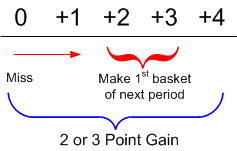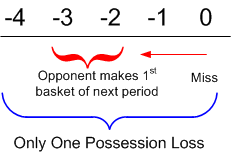- Offensive Techniques & Strategies
Last Shot Situations
What to Discover or Recall:
Discover that a single shot can make the difference in winning or losing along with determining a team's play-off hopes.
Learn that a last shot situation is not just a simple matter of drawing up a play.
Comprehend why and when you should hold for the last shot of a period.
Explore last shot strategies and guidelines.Don't Leave Last Shots Up to Chance

| Why Hold? | Timing | Strategy | Guidelines |
A last shot situation is not just a simple matter of drawing up a play. There are numerous last shot situations to address dependent on court location and time on the clock. When the outcome of the game comes down to a single shot, teams must maintain their poise and confidence. This confidence comes from being prepared.
-
Be sure to get the ball into the hands of your best player, and let them hit the open shot or teammate. Never allow your best player to take the ball out of bounds.
-
Players must read the defense and immediately take advantage of any defensive overplay. The type of defense being deploy will ultimately determine the last shot option. Normally, they will play soft if ahead and must pressure when behind.
-
Non-shooters should be well drilled to go to the offensive boards instead of watching the flight of the ball. Most last second games are won on putbacks not the shot.
-
Keep the play simple and execute. The more complex the action, the greater chance that a breakdown will occur.
-
Practice various last shot scenarios using the game clock. This not only develops proper play timing, spacing and execution, but it also builds players confidence that they can score with just seconds remaining.
Physical conditioning also plays a vital role late in a game. The team that is in better shape will definitely have the advantage in very tense games where players are physically tired, mentally beat, and emotionally drained. Note: normally, you can expect to win at least two games during the season by being in better shape that your opponents.

Why Hold for Last Shot?
Most coaches and players take holding for the last shot of a period on face value and do not know the real value of holding for one shot. However, if you take a moment to analyze the value of taking the last shot of a period, you will see that when the final possession of a period is coupled with the first possessions of the next period amounts to a significant change in the score that can quickly affect the outcome of a game.

By looking at the above line graph, if a team makes the last shot on a period plus first shot of next period it can result in 4 to 6 points. On the other hand, if their opponent makes last shot along with first shot of next period it will amount to a -4 to -6 point deficient. Therefore, the difference of taking the last shot can be anywhere from +6 to -6 or 12 point fluctuation in score. This swing can be even more (14 points) if a shooter gets fouled!

If last shot of the period is missed and you make first shot of next period it results in a 2 or 3 point gain.

Even when the opponent makes first shot of next period you are still in the game since it will only effect score by one possession (2 or 3 points).

Last Shot Timing - Basic Rule
Automatically hold for last shot with less than 30 seconds remaining in period when leading or trailing by less than eight (8) points.
10 Seconds
Players need to be in position for play
8 Seconds
Initiate play
3-5 Seconds
Take the shot & go to offensive boards for second effort.
0-2 Seconds
If opponent does rebound they will not have enough time to advance ball down court for shot
Fundamentals
Most last second shot plays require long passes. Therefore, players should practice and master the skill of making a skip pass (a crisp, accurate pass from sideline to sideline) along with a baseball or semi-hook pass from the backcourt endline to the opposite free throw line ("Elbow"). If players can not execute either of these passes, any last second shot play becomes worthless.
Players should occasionally practice half court shots. This usually requires developing a two handed shot. With practice some players can become fairly accurate. A shoot around practice before game is a good time to practice half court shots. You can also end practices with a half court shot. Reward the first player to make one. Players love the challenge of trying to make half court shots.
Players should practice tipping the basketball and re-directing a pass (less than second). The ability to tip the ball with both the right and left hand also plays an important role in offensive rebounding. Remember, most last shot games are won on the putback not the shot.
Intentionally missing a free throw
Chances are good during the season that an end of game situation will be encountered that requires the intentionally missing of a free throw; therefore, teams must be prepared for it. Intentional missing a free throw must be taught and practiced. Players must recognize and know what their assignments are on an "intentionally" missed free throw situation. Shooters must not only practice the intentional miss, they also need to be aware of the rule that the ball must hit the rim on the attempt.

Last Shot Strategies
1. Save your time outs.
You need a minimum of two at the end of close games. Communicate: be sure that all of your players know the timeout situation.
In a NBA Playoff game with three seconds to go and the game tied, a defensive player rebounded the ball and heaved it unsuccessfully the length of the floor. However, the team had a time out remaining???
In a NCAA Championship game, trailing by two points with 11 seconds remaining, a defensive player upon obtaining a rebound immediately takes a time out. However, the team did not have any timeouts remaining, resulting in a technical foul and any chance for the championship???
In another, crucial NCAA Final Four game, in the final seconds a team leading by one point lost the game when they could not inbounds the ball within five seconds and since they had no time outs remaining, could not take a timeout. The other team scored on the ensuing baseline out of bounds play and won the game???
Yet another NCAA Final Four game, with 2.2 seconds remaining down two points, team elected to inbound from the endline and attempted a desperation 3/4 court shot rather then inbounding the ball into the front court and taking a time out (which they had)???
2. With 1-3 seconds remaining you must take a time out.
Note: Sometimes the opponent may take the time out. Obviously, the most difficult last shot situation is when the ball is out of bounds in the back court with only a second or two remaining. However, with a little foresight and preparation teams can execute plays that can result in a decent shot.
3. Less than four seconds, inbound to half court preferably with a pass and take a time out.
It is much better to have ball at half court with 2 seconds than full court with three. It is also better to have the ball at half court with one second remaining than full court with two seconds.
4. Counter Break.
With 3-4 seconds remaining you can push the ball up the court after opponent scores. Most teams will celebrate and relax so take full advantage of this quick break opportunity. Also, remember that on a time out the provides the opponent with an opportunity to set their defense.
5. If at all possible take shot in line with basket.
On dribble penetration, the ball handler should dribble down the middle of the court and take shot straight in line with the basket rather than from a sideline. Bank shots do go in.
6. Have entire bench stand and count down clock.
7. Have someone go to scorers bench and remind the timer not to start clock until ball touches a player inbounds.
It is also a good idea to remind the officials to make sure the timer does starts the clock properly.
8. Be sure to practice last shot plays from both right and left side of the court.
9. Developing and refining passing skills
Passing should play a significant role in every practice. Do not expect your players to make skip passes or baseball passes if you do not constantly work on them.
10. Develop a designated inbounds passer.
Make sure that your inbounds passer can successfully execute long passes and knows the rules.
 Inbounding the Ball Under Pressure
Inbounding the Ball Under Pressure

Last Shot Guidelines
Situation
1-3 Seconds
3-6 Seconds
6-12 Seconds
Out of Bounds
Endline
Fly
(Inbounds Pass Only)Press Break
(2-3 Passes Maximum)Push ball down court and execute last shot play
(Get ball in hands of best player)Sideline
Predetermine SOB Play
(Inbounds Pass Only)Predetermine SOB Play
(2-3 Passes Maximum)Inbounds ball and up predetermined last shot play
(Get ball in hands of best player)Baseline
Predetermine BOB Play
(Inbounds Pass Only)Predetermine BOB Play
(2-3 Passes Maximum)Inbounds ball and up predetermined last shot play
(Get ball in hands of best player)Opponent Field Goal Attempt
Made
Time Out
Execute a FLY out of bounds play
(Inbounds Pass Only)Quick Break Play
Push ball down court and execute predetermined last shot play
(Get ball in hands of best player)Missed
Rebound & Take Time Out
Execute a FLY out of bounds play
(Inbounds Pass Only)Opponent Free Throw Attempt
Made
Execute predetermined FLY endline out of bounds play
(Inbounds Pass Only)Quick Break Play
Push ball down court and execute last shot play
(Get ball in hands of best player)Missed
Rebound & Take Time Out
Execute a FLY endline out of bounds play
(Inbounds Pass Only)Own Free
Throw AttemptIntentionally miss
& crash the boards!
(Know the Rules)4-6 secs Make the Free Throw
Then try to take a charge or intercept inbounds pass. On steal, take an immediate time out. If unsuccessful, foul immediately.
(See Opponent free throw situation)Jump Ball
Anticipate tap and take a time out upon ball possession.
Execute appropriate out of bounds play.
(Know the Rules)Push ball down court and execute last shot play
(Get ball in hands of best player)Maximum Number of Dribbles
Time
Number of Dribbles
3 Seconds
1 Dribble
5 Seconds
3 Dribble
7 Seconds
5 Dribble
Return to Winning Close Games - Click Here
Return to Coaching Strategies - Click Here
Return to HoopTactics - Click Here
© 2026 HoopTactics All Rights Reserved.
